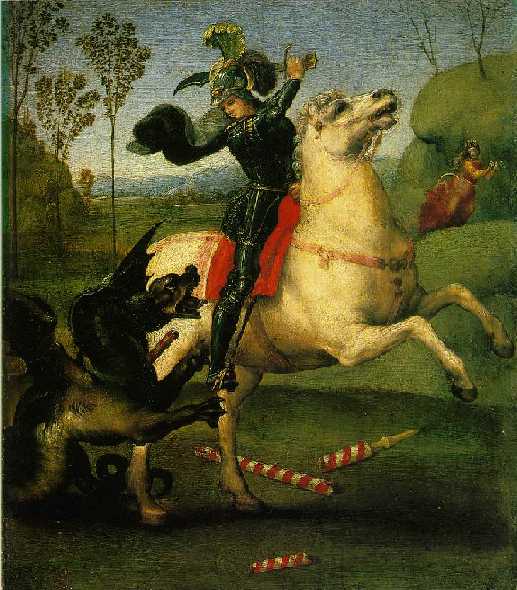



The beginnings of chivalry
Under the influence of the Christian Church towards the end of the eleventh century, knighthood underwent a
noble transformation from military institution to glorious profession, giving the rise to an era when the chivalric
spirit was in its prime. But in tracing the origins of chivalry, some historians insist that we must reach a great deal
further back in time to the rude but wholesome customs of the ancient Germanic tribes who overran the Roman
Empire.Writing in the first century of the Christian era, the Roman historian Tacitus has provided us with a description
of these tribes which, some would argue, has much in common with the system and spirit of later medieval
knighthood. 'The noblest youths', writes Tacitus, 'were not ashamed to be numbered among the faithful
companions of a celebrated leader, to whom they devoted their arms and service.' Indeed, war was fully
embraced by these nomandic tribes, and having attained military age, the youth born of free parents swore
allegiance to his chief and was publicly presented with spear and buckler, belt and sword as a form of knightly
initiation. 'In the hour of danger,' adds Tacitus, 'it was shameful for the chief to be surpassed in valor by his
companions, shameful for the companions not to equal the valor of their chief. To survive him, if he fell, was
irretrievable disgrace. To protect his person, and to increase his glory by their own triumphs, were the most holy
of their duties.' All knights who belonged to this class freeman were also originally equal, a concept which was
maintained throughout the period of medieval chivalry.A further characteristic of the Germanic tribes which anticipates the chivalric spirit of the Middle Ages was the
profound respect they showed towards their women. The nomadic tribes treated their women in a manner
approaching religious veneration and considered marriage a sacred bond. Chastity was placed on par with
heroism,and men consulted their women on every important occasion, seeking their advice and support in times
of battle.It was the Goth who learned the use of cavalry in his conflict with the Romans, asserting himself as 'the lineal
ancestor of all the knights of the Middle Ages' as he unleased his fierce conquering spirit upon the disciplined
infantry of the enemy. An eye-witness account of the Goths in battle dating from AD 470 also conforms, in many
respects, to our image of the medieval knight at arms:'... they wore high, tight, and many-colored garments which
hardly reached down to their bare thighs... Their swords hung down from their shoulders on baldrics, and round
their waists they wore a belt of fur adorned with bosses... In their right hands they held barbed lances and
throwing axes, and in their left shields, on which the light shone, white on the circuit and red on the boss,
displaying bothopulence and craftmanship.'Europe in turmoil
Often described as the Dark Ages, the early Middle Ages saw the decisive collapse of the great Roman Empire,
as hordes of Northern barbarians, including Vandals, Visigoths and Ostrogoths, descended upon the plains of
Gaul, Spain and Italy, subduing and dividing amongst themselves the kingdoms they encountered and destroying
the Roman system of Imperial administration. What followed were centuries of lawlessness and chaos,
interrupted only by the illustrious, yet ambitious, reign of Charlemagne. For even when the restless Teutonic tribes
ceased to be nomadic, their warlike disposition remained active and alive. Once the Romans ceased to be a
threat they began to cross swords with each other, fighting to gain control of land.Renewed turmoil followed the dissolution of Charlemagne's great empire. Petty kingdoms were established by
the greediest and most powerful; each lord or chief assumed the importance of a prince and became a law unto
himself; and everywhere the strong oppressed weaker members of society. All this led to the creation of a
system of government throughout Europe known as fuedalism.Fuedalism
The feudal system, in which fiefs, holdings of land to maintain a lord and his household, were granted by
important overlords in exchange for military support in times of crisis, was properly established during the
Carolingian period as the most effective means of protection against repeated aggression by bands of plunderers.
It was at this juncture that the 'knight' began to emerge as the dominate military force, although far from being the
perfect gentleman serving as an ambassador of chivalry. It would be more appropriate to describe him as a
bloodthirsty soldier, compelled by circumstance and by the terms of his tenure to equal the barbarity of his
aggressor.The feudal 'knight' of the early Norman period, both in England and on the Continent, was a vassal who held his
land in return for his readiness to accompany his lord into the battlefield. More frequently than not his overall
conduct was marked by ferocity and lack of restraint. He was a bandit, a thief and a violator of sacred orders.
Something needed to be done to elevate the knight from barbaric savage to nobleman by adding purpose to his
profession, something which could not remain the responsibility of those few fighting lords sick and weary of the
suffering they witnessed around them. Fortunately, the solution was close at hand. The Church began to promote
the marriage of war and religion, and it was as a result of the Christian Crusades, which achieved this union,
that medieval chivalry came into bloom.


aaron_neilson@usa.net URL: https://members.tripod.com/~aaron_neilson/birth.html